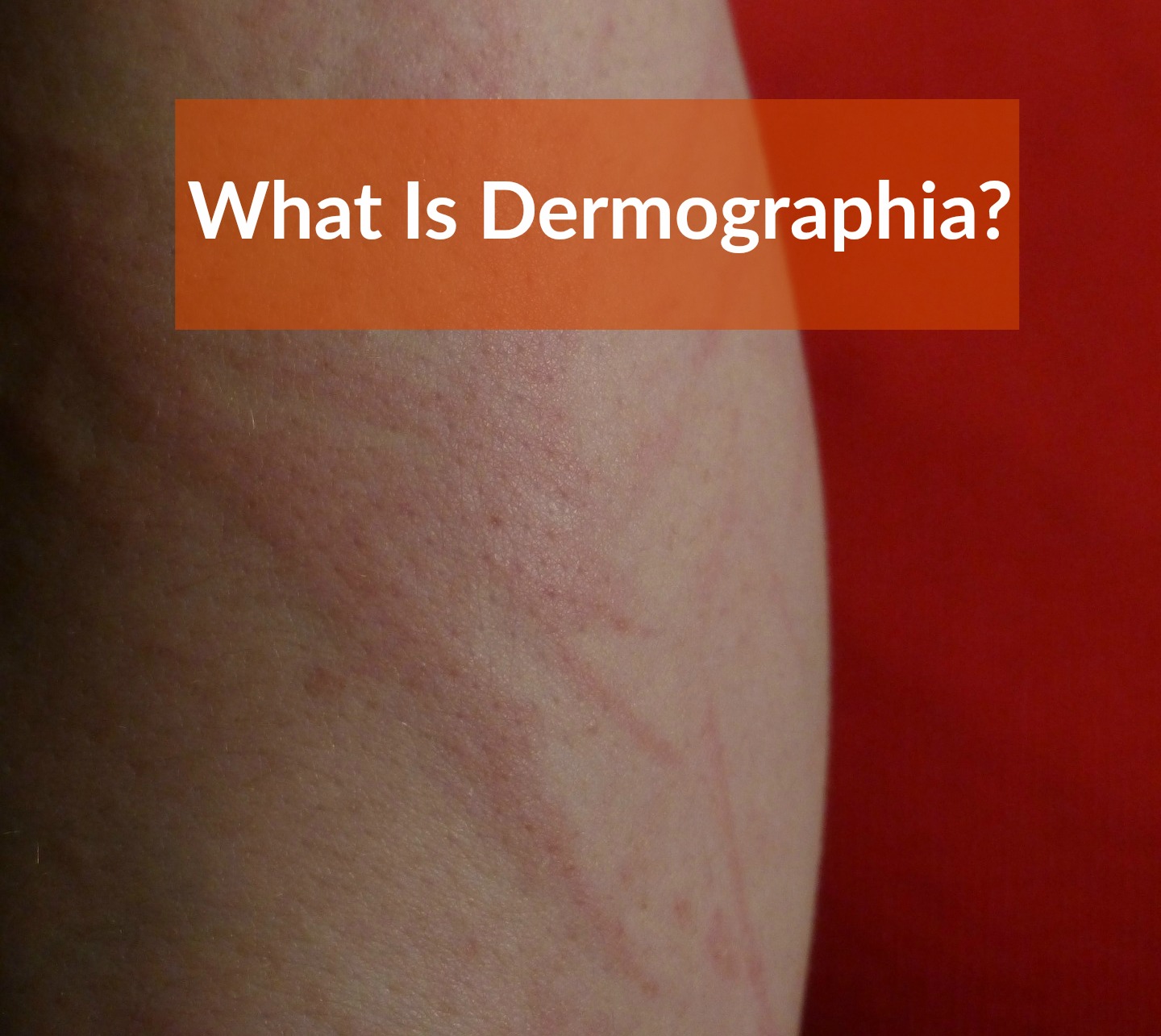The clinical term of dermographia is dermatographic urticaria but it is commonly known as skin writing.
As the name suggests, it is a type of skin disorder. While most sufferers do not experience pain, the commonly experienced symptoms can often be a nuisance.
Understanding this condition comprehensively can go a long way in efforts to manage it.
What It Is
Dermatographic urticaria is referred by several different names including;
» dermographia (dermographism)
» chronic urticaria
» and skin writing
When the sufferer’s skin is rubbed with pressure or lightly scratched, welts appear on the skin at the point of contact.
Instead of appearing like a rash, the welts most commonly form in lines. These welts are due to a process of capillary dilation and swelling. Visible welts can remain for minutes and, in some cases, even hours, according to the wikipedia.
Within the broad term, there are five types of dermographia;(1)
» Simple dermographia is the simplest and most common.
» Delayed dermographia is evident when there is a longer delay before welts appear following contact, and it takes longer for the welts to disappear.
» Cholinergic dermographism involves the appearance of welts after sweating.
» Follicular dermographism involves the skin’s follicles.
» Familial dermographia is the name given to sufferers who have inherited the condition through a genetic link.
Causes
While exact causes of dermographia are not completely known, according to the mayoclinic, research has suggested several possible explanations.(2)
Suspected culprits include an allergic response, side effects of medications, a byproduct of infection, or the result of another condition. It is known, however, that the mast cells of the skin release a histamine.
Mast cells are a type of white blood cell found in the skin. When these cells release histamines, small blood vessels leak and lead to swelling.
Many medical professionals have come to believe that dermographism is an autoimmune condition. This is likely because the body’s cells produce an excessive amount of antibodies that attack other cells. Essentially the body is creating an unnecessary attack against itself.
Ongoing studies are being performed to help medical professionals pinpoint exact causes of dermographia. There is still a lot about the body and how it works on a cellular level that is unknown.
Moreover, it has been previously determined that because people with dermographia have an increased level of histamines present, the condition can be classified as an autoimmune condition.(3)
There are also several conditions that may lead to dermographia. It is believed that mastocytosis, a disease affecting mast cells, can cause dermographism.
In fact, a study conducted in 2000 and published in the British Journal of Dermatology, showed the dermographism was a commonly occurring initial symptom of previously undiagnosed cases of mastocytosis.(4)
In addition to mastocytosis, dermatitis is another skin condition that is believed to cause dermatographic urticaria symptoms. Thyroid disease, hepatitis, some types of infections, and cancer may also be responsible. More research is necessary to determine the role that other conditions may play in the presence of dermographia.
Symptoms
 According to Dr. Amanda Oakley, the most recognizable symptom of dermographia is the red, raised welts that occur following skin contact.(5)
According to Dr. Amanda Oakley, the most recognizable symptom of dermographia is the red, raised welts that occur following skin contact.(5)
These welts generally follow the path of contact, which is why it has been called skin writing. Other symptoms can occur in conjunction with the welts, including itchiness and sometimes a light burning sensation.
In some cases, sufferers experience the itching or burning sensations without the presence of welts. If the condition is more severe, sufferers may experience widespread symptoms following contact.
The severity of dermatographic urticaria symptoms can be triggered or worsened by factors such as stress, according to Bhupinder Kaur, MD, the type of clothing worn, and extreme temperature fluctuations.(6)
Some sufferers may also notice an increase in sun sensitivity and sensitivities to products such as lotions, soap, and perfumes.
Diagnosis
Even though exact causes cannot always be pinpointed, doctors will run a series of tests that will help narrow down any suspicions. Generally, blood tests are performed to determine white blood cell counts, the possibility of issues on a cellular level, and to determine if there is an abundance of histamines present.
It is also a possibility that a comprehensive allergy test will be recommended, if only to rule out the allergy response element.
One of the most common methods to determine dermographia is a physical skin test. A doctor can use a tongue depressor or the back of a pen to draw across the skin’s surface.
If a welt appears, the doctor may perform this test again to test the length of time it takes for a welt to appear again. From this point, further testing may be recommended.
[youtube id=”3k7bZbmJOvE” width=”700″ height=”440″ position=”left”]
Treatment
The most commonly recommended treatment for dermographia is an antihistamine.(2,5) These medications are frequently used to aid in treating seasonal and environmental allergies.
Antihistamines block the production of histamines, so it is possible they will work to block the release of histamines by mast cells. Sufferers may be able to alleviate discomfort from the welts by using cool or warm compresses.
If broken skin appears along with the welts, it is important to take proper hygiene steps to ensure that infection does not occur.
In addition to histamines, a doctor may recommend the use of steroidal treatment to aid the body in symptom management. Steroids in low dosages tend to be beneficial for people who have allergic reactions, autoimmune issues, and experience the itching or burning sensations that occur with the presence of welts.
Home Management
Since it is not always possible to avoid irritants that trigger a reaction, it is a good idea to learn different methods to deal with reactions that may occur despite treatments.
In addition to antihistamines, there are steps that sufferers can take at home to help manage dermographia and its symptoms. Stress reduction can be achieved by learning relaxation techniques.
The skin should be kept moisturized by drinking plenty of water and using a hypoallergenic moisturizing lotion. Avoid clothing that triggers the development of welts.
Sufferers should avoid exposure to extreme cold or heat. Topical remedies, such as chamomile oil, may also be beneficial in alleviating symptoms.(7) If hot water causes aggravation, take lukewarm showers or baths. It may also be recommended to make some dietary changes if there are suspected food triggers.
When to See a Doctor
 If someone has unexplained welts appearing, medical care should be sought so that a diagnosis can be obtained. For sufferers who have already received a diagnosis, there are specific instances when it will be necessary to return to the doctor.
If someone has unexplained welts appearing, medical care should be sought so that a diagnosis can be obtained. For sufferers who have already received a diagnosis, there are specific instances when it will be necessary to return to the doctor.
Generally, doctors will continue to monitor the condition and the success of any medications that were recommended. Sufferers will need to seek prompt medical attention if welts do not subside within a normal time frame, if there are signs of infection, or if symptoms seem to be worsening.
Immediate medical attention is required if medications are causing dangerous side effects such as difficulty breathing.
Conclusion
Dermographia occurs in 4–5 percent of the general population, and is more likely to develop in children and young adults.(8) There currently is no known cure for the condition.
Some cases clear up on their own with time, but many instances of dermographism cause lifelong symptoms for sufferers. Managing symptoms as they occur is the key to maintaining a somewhat normal quality of life.
Through symptom management, sufferers can reduce itching and burning sensations that present with the appearance of welts.
Following diagnosis, it is often recommended that sufferers make notes about physical activities, hygiene activities, diet, and other such things to effectively determine, and further avoid, potential triggers.
References
(1)http://www.ijdvl.com/article.asp?issn=0378-6323;year=2008;volume=74;issue=2;spage=177;epage=179;aulast=Bhute
(2)http://www.mayoclinic.org/diseases-conditions/dermatographia/basics/causes/con-20025360
(3)https://www.ncbi.nlm.nih.gov/pubmed/2774302
(4)https://www.ncbi.nlm.nih.gov/pubmed/11069538
(5)http://www.dermnetnz.org/topics/dermographism/
(6)http://www.medhelp.org/posts/Allergy/Dermographia/show/596799
(7)http://www.stylecraze.com/articles/amazing-benefits-of-chamomile-oil-for-skin-health-and-hair/
(8)http://onlinelibrary.wiley.com/doi/10.1002/ajmg.1320390216/abstract
Leave Feedback: Was this article helpful?

